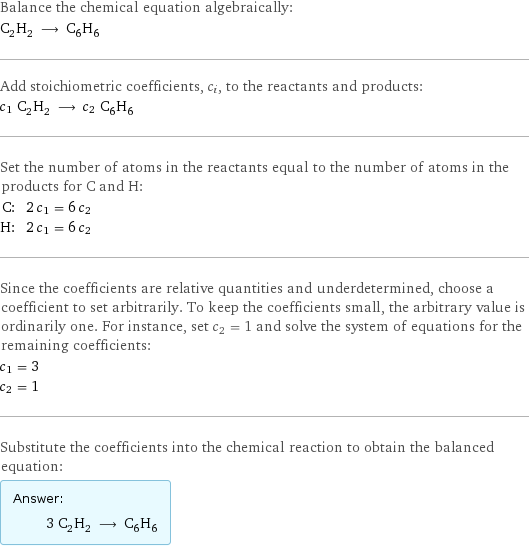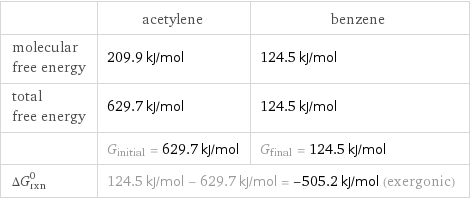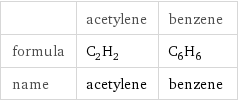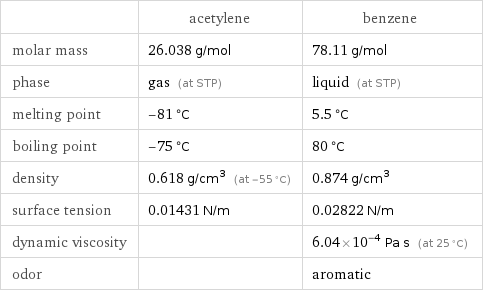Input interpretation

C_2H_2 (acetylene) ⟶ C_6H_6 (benzene)
Balanced equation

Balance the chemical equation algebraically: C_2H_2 ⟶ C_6H_6 Add stoichiometric coefficients, c_i, to the reactants and products: c_1 C_2H_2 ⟶ c_2 C_6H_6 Set the number of atoms in the reactants equal to the number of atoms in the products for C and H: C: | 2 c_1 = 6 c_2 H: | 2 c_1 = 6 c_2 Since the coefficients are relative quantities and underdetermined, choose a coefficient to set arbitrarily. To keep the coefficients small, the arbitrary value is ordinarily one. For instance, set c_2 = 1 and solve the system of equations for the remaining coefficients: c_1 = 3 c_2 = 1 Substitute the coefficients into the chemical reaction to obtain the balanced equation: Answer: | | 3 C_2H_2 ⟶ C_6H_6
Structures

⟶
Names

acetylene ⟶ benzene
Reaction thermodynamics
Gibbs free energy

| acetylene | benzene molecular free energy | 209.9 kJ/mol | 124.5 kJ/mol total free energy | 629.7 kJ/mol | 124.5 kJ/mol | G_initial = 629.7 kJ/mol | G_final = 124.5 kJ/mol ΔG_rxn^0 | 124.5 kJ/mol - 629.7 kJ/mol = -505.2 kJ/mol (exergonic) |
Equilibrium constant
![Construct the equilibrium constant, K, expression for: C_2H_2 ⟶ C_6H_6 Plan: • Balance the chemical equation. • Determine the stoichiometric numbers. • Assemble the activity expression for each chemical species. • Use the activity expressions to build the equilibrium constant expression. Write the balanced chemical equation: 3 C_2H_2 ⟶ C_6H_6 Assign stoichiometric numbers, ν_i, using the stoichiometric coefficients, c_i, from the balanced chemical equation in the following manner: ν_i = -c_i for reactants and ν_i = c_i for products: chemical species | c_i | ν_i C_2H_2 | 3 | -3 C_6H_6 | 1 | 1 Assemble the activity expressions accounting for the state of matter and ν_i: chemical species | c_i | ν_i | activity expression C_2H_2 | 3 | -3 | ([C2H2])^(-3) C_6H_6 | 1 | 1 | [C6H6] The equilibrium constant symbol in the concentration basis is: K_c Mulitply the activity expressions to arrive at the K_c expression: Answer: | | K_c = ([C2H2])^(-3) [C6H6] = ([C6H6])/([C2H2])^3](../image_source/e07c098cbc6e4df08c6e66ef2f5cef34.png)
Construct the equilibrium constant, K, expression for: C_2H_2 ⟶ C_6H_6 Plan: • Balance the chemical equation. • Determine the stoichiometric numbers. • Assemble the activity expression for each chemical species. • Use the activity expressions to build the equilibrium constant expression. Write the balanced chemical equation: 3 C_2H_2 ⟶ C_6H_6 Assign stoichiometric numbers, ν_i, using the stoichiometric coefficients, c_i, from the balanced chemical equation in the following manner: ν_i = -c_i for reactants and ν_i = c_i for products: chemical species | c_i | ν_i C_2H_2 | 3 | -3 C_6H_6 | 1 | 1 Assemble the activity expressions accounting for the state of matter and ν_i: chemical species | c_i | ν_i | activity expression C_2H_2 | 3 | -3 | ([C2H2])^(-3) C_6H_6 | 1 | 1 | [C6H6] The equilibrium constant symbol in the concentration basis is: K_c Mulitply the activity expressions to arrive at the K_c expression: Answer: | | K_c = ([C2H2])^(-3) [C6H6] = ([C6H6])/([C2H2])^3
Rate of reaction
![Construct the rate of reaction expression for: C_2H_2 ⟶ C_6H_6 Plan: • Balance the chemical equation. • Determine the stoichiometric numbers. • Assemble the rate term for each chemical species. • Write the rate of reaction expression. Write the balanced chemical equation: 3 C_2H_2 ⟶ C_6H_6 Assign stoichiometric numbers, ν_i, using the stoichiometric coefficients, c_i, from the balanced chemical equation in the following manner: ν_i = -c_i for reactants and ν_i = c_i for products: chemical species | c_i | ν_i C_2H_2 | 3 | -3 C_6H_6 | 1 | 1 The rate term for each chemical species, B_i, is 1/ν_i(Δ[B_i])/(Δt) where [B_i] is the amount concentration and t is time: chemical species | c_i | ν_i | rate term C_2H_2 | 3 | -3 | -1/3 (Δ[C2H2])/(Δt) C_6H_6 | 1 | 1 | (Δ[C6H6])/(Δt) (for infinitesimal rate of change, replace Δ with d) Set the rate terms equal to each other to arrive at the rate expression: Answer: | | rate = -1/3 (Δ[C2H2])/(Δt) = (Δ[C6H6])/(Δt) (assuming constant volume and no accumulation of intermediates or side products)](../image_source/d6c24396858ec3994a6b6f9e0243f660.png)
Construct the rate of reaction expression for: C_2H_2 ⟶ C_6H_6 Plan: • Balance the chemical equation. • Determine the stoichiometric numbers. • Assemble the rate term for each chemical species. • Write the rate of reaction expression. Write the balanced chemical equation: 3 C_2H_2 ⟶ C_6H_6 Assign stoichiometric numbers, ν_i, using the stoichiometric coefficients, c_i, from the balanced chemical equation in the following manner: ν_i = -c_i for reactants and ν_i = c_i for products: chemical species | c_i | ν_i C_2H_2 | 3 | -3 C_6H_6 | 1 | 1 The rate term for each chemical species, B_i, is 1/ν_i(Δ[B_i])/(Δt) where [B_i] is the amount concentration and t is time: chemical species | c_i | ν_i | rate term C_2H_2 | 3 | -3 | -1/3 (Δ[C2H2])/(Δt) C_6H_6 | 1 | 1 | (Δ[C6H6])/(Δt) (for infinitesimal rate of change, replace Δ with d) Set the rate terms equal to each other to arrive at the rate expression: Answer: | | rate = -1/3 (Δ[C2H2])/(Δt) = (Δ[C6H6])/(Δt) (assuming constant volume and no accumulation of intermediates or side products)
Chemical names and formulas

| acetylene | benzene formula | C_2H_2 | C_6H_6 name | acetylene | benzene
Substance properties

| acetylene | benzene molar mass | 26.038 g/mol | 78.11 g/mol phase | gas (at STP) | liquid (at STP) melting point | -81 °C | 5.5 °C boiling point | -75 °C | 80 °C density | 0.618 g/cm^3 (at -55 °C) | 0.874 g/cm^3 surface tension | 0.01431 N/m | 0.02822 N/m dynamic viscosity | | 6.04×10^-4 Pa s (at 25 °C) odor | | aromatic
Units
